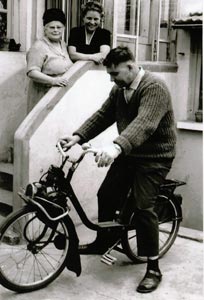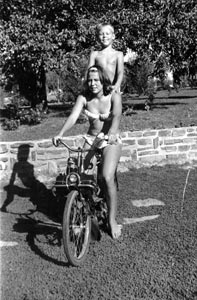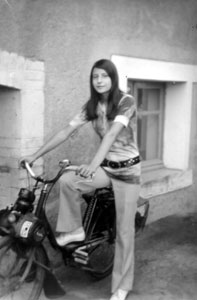![]() THE SOLEX 2200
THE SOLEX 2200 ![]()
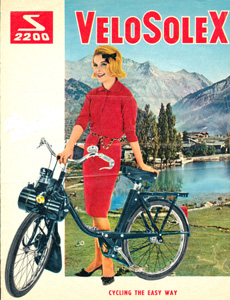
JUNE 1961
Cycling the easy way
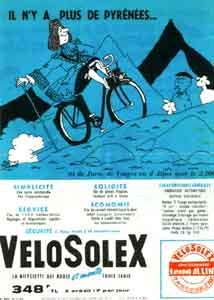
- New motor, more powerful, 3000 rpm.
- Anti-parasitic ignition.
- New, black air filter cover with the S 2200 insignia.
- New cylinder head with the spark plug vertical from October, 1962 onwards.
- New handle bar with the control synchronized by the same cable between
the front brake and the gas.
VELOSOLEX 348 F ON CREDIT 1 FRANC PER DAY !
The Solex S 2200 was sold from June,1961 until September,1964
| Month Year | Motor number | Price |
| June 1961 | 2.202.001 | 348 NF |
| January 1962 | 2.386.650 | |
| January 1963 | 2.705.990 | 353 F |
| January 1964 | 3.041.150 |
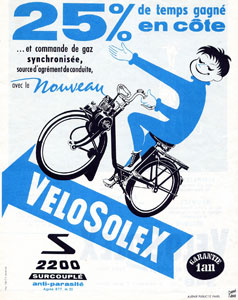
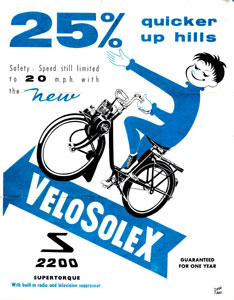
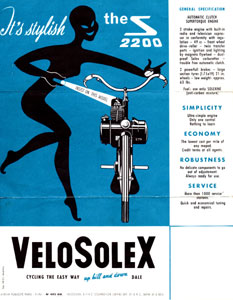
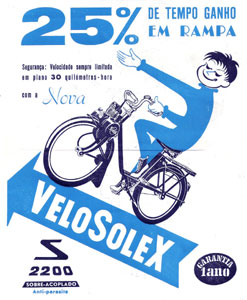
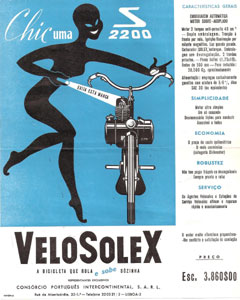
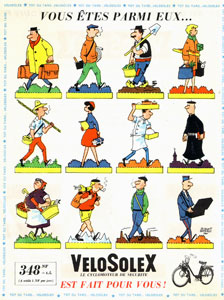
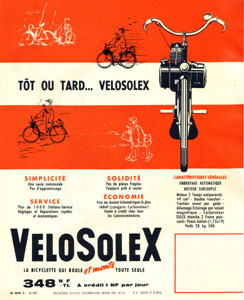
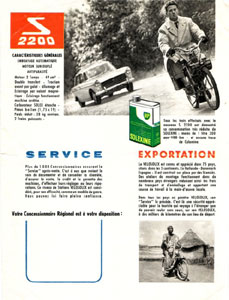
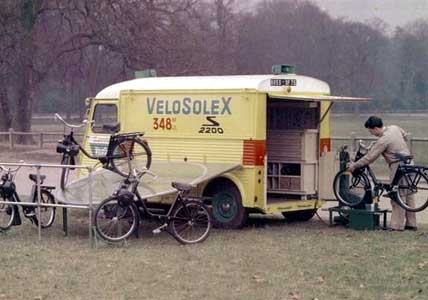
THE SOLEX 2200 IN PARIS FASHION
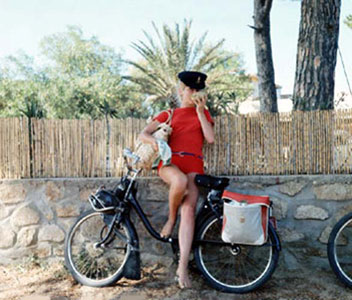
Catherine Deneuve in Saint Tropez in 1962 posing in front of a Solex 2200
to show the fashions of the Parisian designers Christian Dior and Yves
Saint-Laurent in the American publication “Life Magazine ”.
This scene has been immortalized by the famous photographer Milton H.
Greene (1922-1985).
THE SOLEX 2200 IN MOVIE POSTER
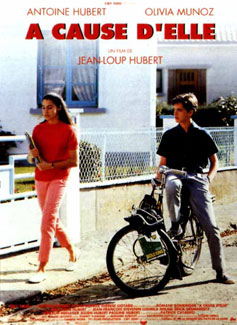
RECORDS AND CELEBRITIES WITH A SOLEX S 2200
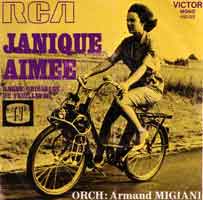
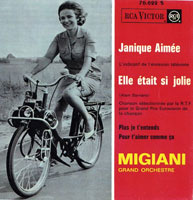
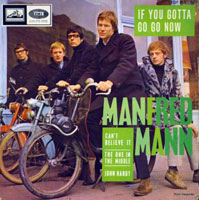
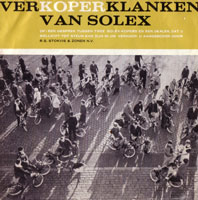
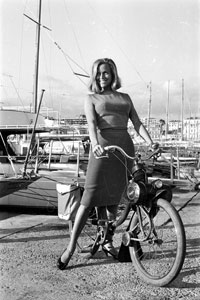
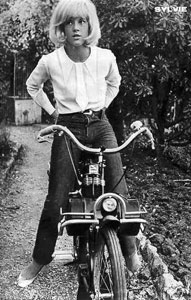
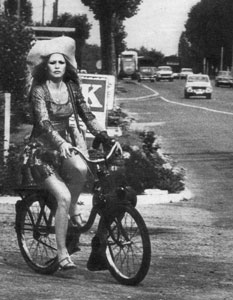
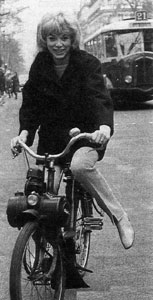
DANIEL'S 2200 IN 1962 IN CAUSSADE
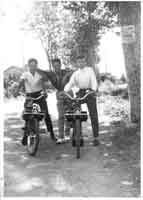
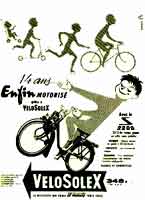
AUGUST 1962
The young Daniel Gutierrez (member of Solex-Millenium and the Belgian
Solex Club) on the left in the photo, receives a Solex 2200 for his 14th
birthday, he is next to his friend, Aldo Ferreri, also an owner of a Solex
2200.
Photo taken in Caussade (Tarn & Garonne)
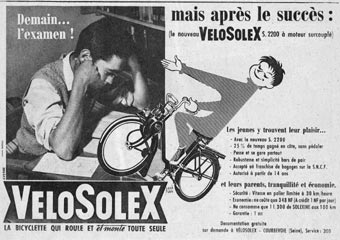
EXCERPT FROM THE CYCLE-NUMBER 17 FROM SEPTEMBER 1961

Now, all information taken, this symbol is the subdued sign of a new evolution of the “bicycle that
rolls by itself”. VELOSOLEX, as you know, is resolutely against “sensational news”. The great firm from Courbevoie has not
stopped improving their machine since its launching, about fifteen years ago, but it does it without flashy publicity and, above all, it remains
faithful to an idea that has made the machine a success.
The VELOSOLEX customer can “follow” his brand: he knows that in each machine he will find again the essential qualities of the previous
one. But, he also knows that he will certainly discover an additional benefit, generally well hidden, in the secret of the carefully sheltered
mechanics.
The same user has appreciated, for two years now, the automatic “compound”
clutch, added to make urban traffic considerably easier. Today, he gains
without realizing it, if he doesn’t pay attention to the comparative
testing, by the improvements very quietly concealed under the S 2200 insignia.
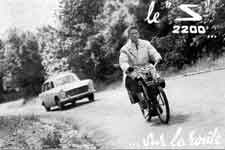
Following the new Velosolex S 2200 on the road.
62 miles, in the numerous hills of the Vallée de Chevreuse, covered
at an average speed of 17 mph, have demonstrated the remarkable climbing
qualities of the S 2200.
The new VELOSOLEX is named S 2200.
It is immediately identifiable by the black air filter hood with the white
S 2200 insignia on it. The spark plug angle has also been modified and
it’s no longer visible on the face of the cylinder as in the past.
This new model, which replaces the VELOSOLEX 1700, includes important,
new technical aspects, which are conveyed to the owner by:
- a distinct increase in power going uphill.
- more rapid acceleration.
- in general, a greater average speed, coming from the aforementioned
advantages, and not from the top speed, which remains controlled at 19
mph.
Besides, the VELOSOLEX 2200 motor is bound by controlling terms approved
by the R.T.F.
It is important to point out, all the same, these improvements:
- the price of the new VELOSOLEX remains unchanged: 348 NF
- the gas mileage has not varied, 1.38 qt of Solexine per 62 mi.
- its guarantee is still one year.
Concerning the theoretical plan, the VELOSOLEX technicians applied themselves
to obtaining a graphic curve of motor power at full throttle better in
the mid-range zone. This zone is exactly that in which the VELOSOLEX,
approaching a hill, slows down, and needs to maintain its maximum torque.
This engine torque, in the S2200, is increased, compared to the old model,
by 25 to 30% between 1,700 and 3,000 rpm, ranges corresponding to speeds
situated between 9 and 16 mph.
It can be said that the VELOSOLEX S 2200 is at least 25% quicker uphill and, as we have already said, without the rider having to supply the slightest effort; that moment when the rider must begin to pedal, if the hill is very steep, is found to be much later.
Concerning the practical plan, very rigorous testing, which we are relating here, done with machines exactly
the same as those that are delivered to the customer, has eloquently demonstrated
the advantages of the increase in climbing power:
The VELOSOLEX S 2200, ridden by a cyclist weighing 176 lb., climbs the hills of Picardie (in both directions) or the hill of “17 Turns”
in the Vallée de Chevreuse, which contain sections exceeding 7%, without pedal assistance and with an average speed of 12.4 mph.
We had wished to check out these improvements and measure the performance. VELOSOLEX lent themselves to the tests that we are presenting a little
further than the report given. Previously, M. Petiot (director of VELOSOLEX production) approached the problem from his own angle:
“We are locked into, since the creation of the machine around 1942, and then when its sale was rendered
impossible by the circumstances that you know about, this idea of “the bicycle that rolls by itself” and we intend to remain faithful to
it. It had been put to us to increase the speed of the VELOSOLEX. We hadn’t wanted to do it. We thought that, to be both dependable and economical,
to be usable by everyone, to keep its indispensable utilitarian character,
our machine must not actually go beyond 19 mph.
The objective was entirely attained, you know, since at the present time our production is 1,300 units per day; since, also, the VELOSOLEX constitutes
a unique category; since, finally, on the subject of economy, we are proud of not having to modify our price since 1954.
Then it was up to us to not rest on our laurels, there had still been a margin that we had not overcome. The top speed is one thing; the average
speed is another. It was well known that if one must be at a fixed maximum level, the other could be improved. The ideal, in our mind, would be obtaining
a 19 mph constant speed, whatever the road configuration is, whatever the wind direction is.
We are able to confirm that, with the S 2200, we have taken a great step towards this ideal. How is that? By adding reliable power in uphill situations.
We are not going more quickly, but we climb more and more briskly.”
Nothing remained for us to do but to set up a comparison on the road between the S 2200 and the 1700, still
planned for the beginning of the summer. In fact, if the calculations of the engineers are of any value, the comparative tests will all the
same be much more eloquent.
Still, it’s necessary that this trial be followed seriously and
strictly.
Several basic factors must happen:
1. THE ROUTE.
It is imperative that the circuit chosen includes an urban section (traffic jams, stops at signal lights,
etc.) then, in the rural sections, a suitable dosage of flats, uphills and downhills.
It is why the route adopted was:
Eiffel Tower, Pont de Saint-Cloud, Boulogne, Saint-Cloud Hill, Pont-Noir hill, Picardie hill, Versailles, Saint-Cyr, Trappes, Rambouillet, Dampierre,
17 Turns Hill, Port-Royal hill, Voisins-le-Bretonneux, la Miniere, Satory,
Versailles, Picardie hill, Pont of Saint-Cloud, Eiffel Tower.
In covering 62 miles, we are obtaining all that could be desired.
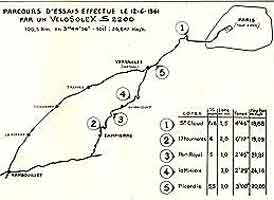
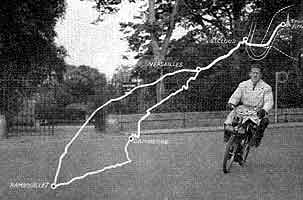
2. THE RIDERS.
It would not have been a strictly honest test to be content with crossing a deserted Paris at the calmest hours; in short, not placing the machines in normal operating conditions. That’s why the test took place in the heart of the morning on a working day. And we add that, for its part, the weather was not particularly agreeable that morning: strong wind, ground occasionally wet.
3. THE DENSITY OF THE TRAFFIC.
It would not have been a strictly honest test to be content with crossing a deserted Paris at the calmest hours; in short, not placing the machines in normal operating conditions. That’s why the test took place in the heart of the morning on a working day. And we add that, for its part, the weather was not particularly agreeable that morning: strong wind, ground occasionally wet.
TESTING PERFORMED MONDAY, JUNE 12th, 1961
62.3 mi. in 3h 44m 36s Let’s say: 16.65 mph
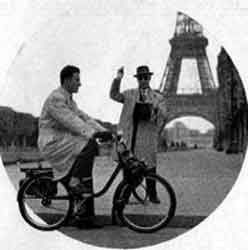
At the foot of Tour-Eiffel, the official time-keeper, Mr.Robrieux, prepares to give the signal to start the 100 km to the S 2200 rider at 7:24 am.
We have called the roll of the official timekeeper of major automobile and cycle competitions, Mr. Robrieux. This
man of figures had been entrusted, additionally, with calculating the distances and surveying the measurements.
One will note that, from the start, the hourly average uphill was always extremely respectable:
11.6 mi or the ascent from the Pont de Saint-Cloud to the Montretout traffic circle 25 km
15.6 mi for Picardie
12.3 mi for the 17-Turns
15 mi for The Miniere
12.4 mi for the Versailles side of Picardie (much steeper than the Fausses-Reposes.
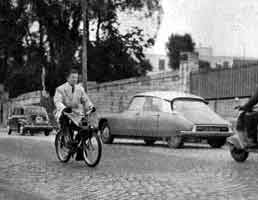
The rue Dailly, in Saint-Cloud, was climbed
briskly in the middle of intense traffic.
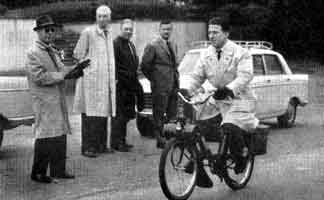
At the summit of Picardie hill, approaching Ville-d’Avray, the “S 2200” passes in front of the official timekeeper, Mr. Robrieux and Messrs. Madsen,
Claude Tillet and Daniel Rebour.
It goes without saying that it had not been a matter of pedaling and that this is absolutely firm, that the
rider of the S 2200 had climbed these inclines like a tourist, calm and stylishly elegant.
The rider of the 1700 had not been so calm. He lost regularly everywhere.
- 91 seconds in Saint-Cloud
- 58 seconds in the 17-Turns where he had to pedal ever so slightly so
as not to be
irremediably distanced
- 89 seconds in Port-Royal
- 42 seconds in La Miniere
- 34 seconds in Picardie
Very visibly, he had experienced less pleasure than his comrade, and if
he did not finish after some minutes, the accompanying cars, if the occasion
presented itself, helped to restore the situation.
But concerning the S 2200, some other observations had been made:
1 - Always, except in the descents, the speed had not been more than 19
mph
2 - All of the hills had been climbed without effort and without assistance.
3 - The general hourly average, of 16.5 mi for the route going (with unfavorable
wind) became 17.1 for the return route, and the overall average was established
at 16.6 mi.
The demonstration was completely conclusive. It could even be considered
rather sensational, because it is not trivial to border upon the average
of 17, on a difficult course, without ever going beyond (except here and
there, 1 mph on the downhill) the speed of 19 mph.
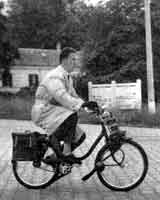
A little before arriving at Rambouillet at the entrance to the nice straight road running along the forest.
But to what extent had the rules of the game been respected as related to fuel consumption?
We were going to know it, for sure, in going to Longchamp.
After 5 sections averaging 12.4 mi each, the consumption was about 1.4
qt for 62 mi. This is proof enough, if any was needed, that we weren’t
dealing with an engine “souped up” for the occasion.
It is known, finally, but it is not bad to repeat it, that the VELOSOLEX
for a long time has been endowed with excellent braking. What a good occasion,
nevertheless, to ascertain this. Four tests at the maximum speed permitted
the registering of the following distances: 4.5 yd, 4.8 yd, 4.0 yd, 4.6
yards.
The Solex 2200 is, irrefutable documents in hand, a new success.
Let’s add, further, that it is still also silent, an important advantage
in a world deafened by noise. The general characteristics of the VELOSOLEX
have not undergone any essential modifications
We will recall them for you as a reminder:
Two-stroke motor, 49 cc, with double transfer and automatic clutch, roller
drive, the motor has ignition and electrical systems powered by magnetic
flywheel, the front and rear lights function the same if the machine is
stopped, equipped with a special carburetor, without a float bowl assembly,
is a watertight Solex, the Solexine consumption is particularly economical:
1.4 qt for 62 mi.
The cycle portion has not undergone any modifications, the VELOSOLEX is
still the only open frame, its weight is 62.5 lb in running order, it
has balloon tires (19 x 1.75) and two rim brakes.
A last piece of information of notoriety in conclusion:
More than 2,500,000 VELOSOLEX have been put into service since the start
of mass production in 1946 and the only French factories of the brand
(Courbevoie, Arras and Tours) put out more than 1,300 machines each day.
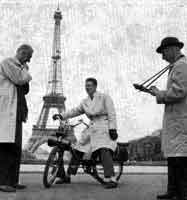
At the arrival of rider and machine naturally in perfect condition!
mileage covered: 60.1 mi
SOLEX 2200 PHOTO GALLERY
